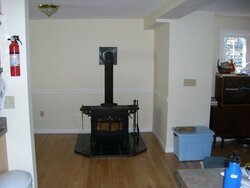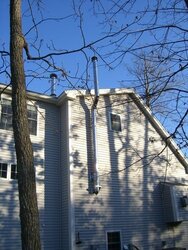Ok, some of you folks take such things for granted, but I was surprised today to find this when I got home.
I left home this morning after loading up - load was sometime before 9a (not exactly sure what time, but it was before 9). I had a good bed of coals and one mostly burned split in there on top of which I loaded three good sized pieces - one of which was a 'monster' piece of 3+ year old oak that I acquired recently as part of a new load of wood. That pretty much filled up the box although there were quite a few good sized gaps in there as the pieces didn't 'fit' well together. I choked the air back slowly to about 1/4 and left it cooking....
Got home about 5:30 and was surprised to find the stove wasn't cold so I took a look inside and started raking the ash around and to my surprise there was actually some glow to the few remaining charcoal bits! Just to see what would happen I piled these together in the front of the stove and sure enough with air open they shortly were lit up into a nice pile that I'm sure I could have used to start a new fire.
So, this was a definite record for me. What changed? Well... two big things and perhaps a third factor come to mind.
1) Better wood - I had a couple pieces of this 3yr oak in there which clearly makes a big difference.
2) OAK input limiter - A few weeks ago I fit a piece of foil over the OAK input such that it covers 1/2 of the surface area. This has clearly tamed my fires and I have seen a significant increase in my heat output as well as the burn times with a corresponding decrease in flue temps while not putting smoke up the chimney (hmmm can anyone say 'overdraft confirmation'?)
3) the minor difference(?) the high temp today was around 45 or so - perhaps warmer temps outside decreased draft enough to help slow burn rate?
Open to ideas and comments - mostly I'm just excited that I may be getting the hang of this stove.. but if factor #3 is the main reason (outside temp) then perhaps my dream for overnight burns when it is cold next year are going to be dashed. Thoughts anyone?
I left home this morning after loading up - load was sometime before 9a (not exactly sure what time, but it was before 9). I had a good bed of coals and one mostly burned split in there on top of which I loaded three good sized pieces - one of which was a 'monster' piece of 3+ year old oak that I acquired recently as part of a new load of wood. That pretty much filled up the box although there were quite a few good sized gaps in there as the pieces didn't 'fit' well together. I choked the air back slowly to about 1/4 and left it cooking....
Got home about 5:30 and was surprised to find the stove wasn't cold so I took a look inside and started raking the ash around and to my surprise there was actually some glow to the few remaining charcoal bits! Just to see what would happen I piled these together in the front of the stove and sure enough with air open they shortly were lit up into a nice pile that I'm sure I could have used to start a new fire.
So, this was a definite record for me. What changed? Well... two big things and perhaps a third factor come to mind.
1) Better wood - I had a couple pieces of this 3yr oak in there which clearly makes a big difference.
2) OAK input limiter - A few weeks ago I fit a piece of foil over the OAK input such that it covers 1/2 of the surface area. This has clearly tamed my fires and I have seen a significant increase in my heat output as well as the burn times with a corresponding decrease in flue temps while not putting smoke up the chimney (hmmm can anyone say 'overdraft confirmation'?)
3) the minor difference(?) the high temp today was around 45 or so - perhaps warmer temps outside decreased draft enough to help slow burn rate?
Open to ideas and comments - mostly I'm just excited that I may be getting the hang of this stove.. but if factor #3 is the main reason (outside temp) then perhaps my dream for overnight burns when it is cold next year are going to be dashed. Thoughts anyone?



